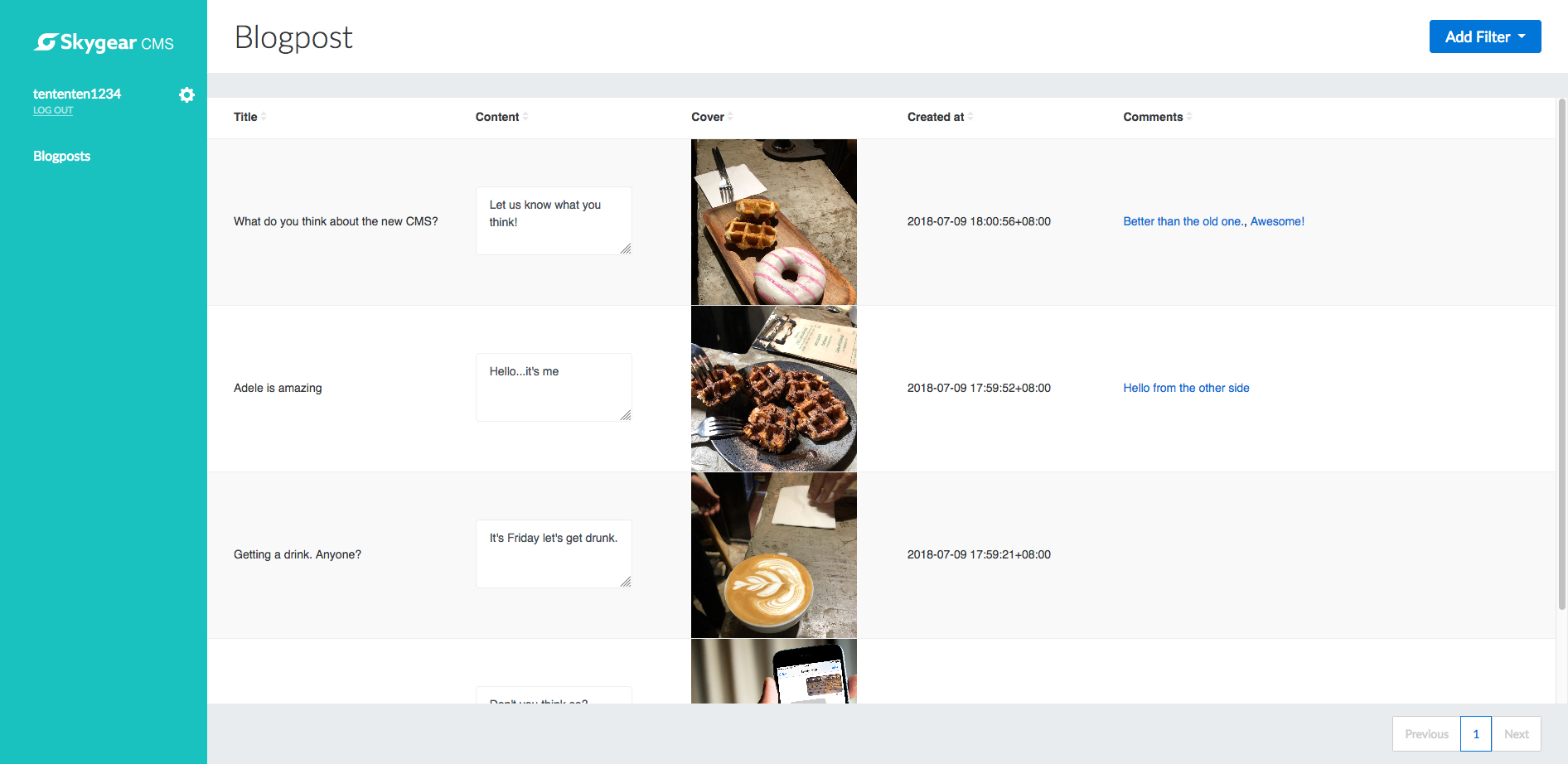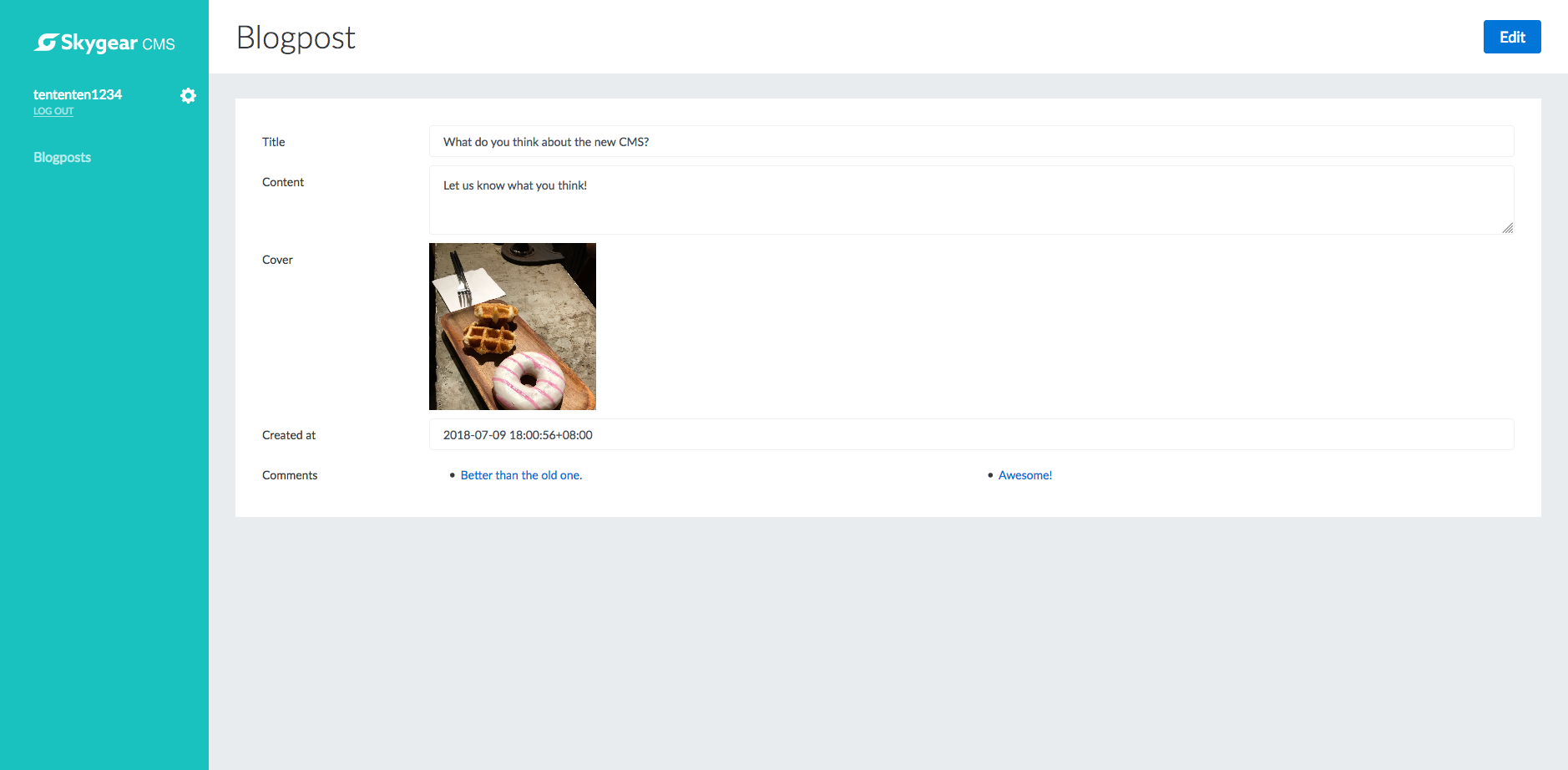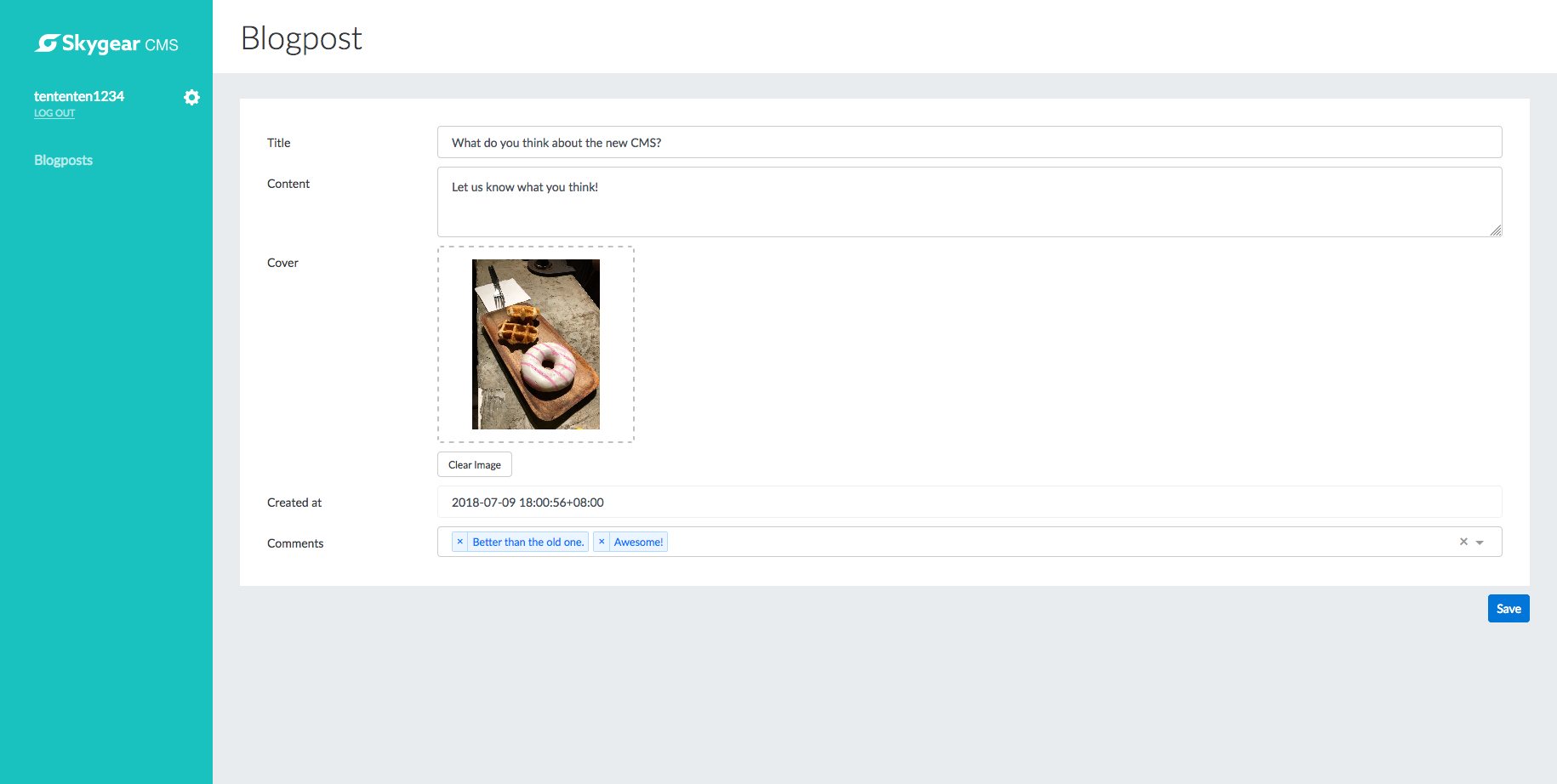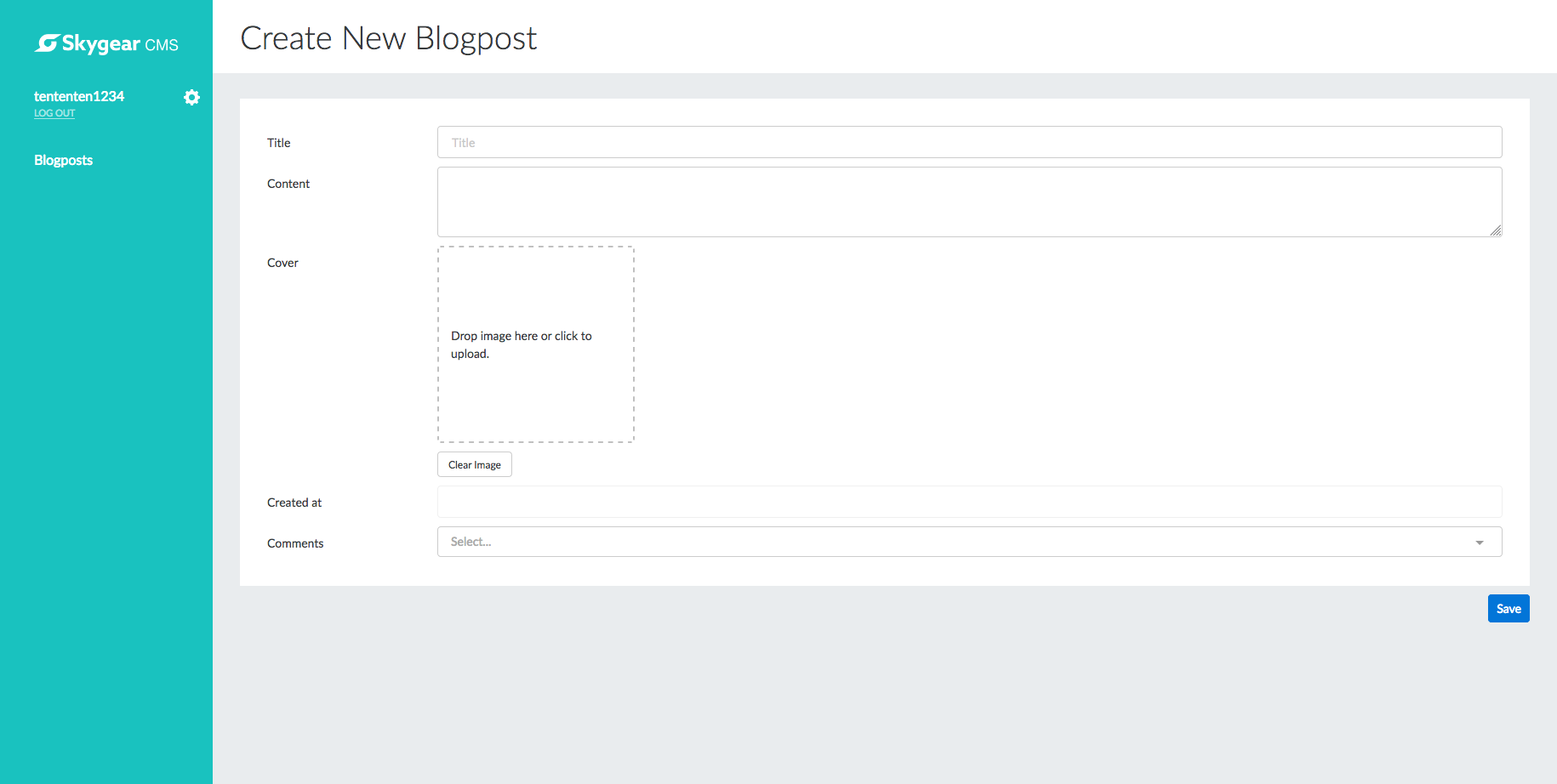Configuring the CMS record page
In CMS basics we learn that the CMS is consisted of 2 types of pages: record and user_management. In this section, we will go into details of the record page configuration.
A record page has 4 views: list, show, edit and new. They are the ways your business users read (list, show), update (edit) or create (new) a record in the CMS.
List view

You can imagine the list view as a spreadsheet that lists out all the records you have in a table.
Example usage:
Assume we have the following tables in our app.
Blogpost
| Fields | Type |
|---|---|
| _id | String |
| _created_at | DateTime |
| _updated_at | DateTime |
| title | String |
| content | String |
| cover | Asset |
Comment
| Fields | Type |
|---|---|
| _id | String |
| _created_at | DateTime |
| _updated_at | DateTime |
| comment | String |
| blogpostId | Reference |
This is what we need:
- Display only the title, the content, the cover and the created time of a blogpost.
- Show the comments a blog post has.
- Users can filter blog posts with title keywords.
- Display only blog posts that are created in 2018.
- Blog posts sorted in descending order based on their created time.
Then we should write in the YAML file:
site:
- type: record
name: blogpost
label: Blogposts
records:
comment:
record_type: comment
blogpost:
record_type: blogpost
list:
fields:
- name: title
type: string
label: Title
- name: content
type: text_area
label: Content
- name: cover
type: image
label: Cover
- name: _created_at
- name: blogpost_comment
label: Comments
type: reference_list
reference_via_back_reference: comment
reference_from_field: blogpostId
reference_field_name: comment
filters:
- name: title
type: string
label: Title
predicates:
- name: _created_at
predicate: greater_than_or_equal_to
value: 2018-01-01
default_sort:
name: _created_at
ascending: false
List view configurable items
record_type
record_type: database table name
It refers to the database table the CMS record is linked to. In the above example, the CMS record blogpost is linked to the database table blogpost.
fields
fields:
- name: field name in the database
type: CMS record type # see the field type guide
label: name to display in the CMS
It refers to the fields you want to display. You may not want to display all the fields of a record as it may confuse your business users. For example, most developers choose to not display the record id.
There are three reserved fields you can use:
fields:
- name: _id
- name: _created_at
- name: _updated_at
Besides, when you configure a field, you have to specify its field types. Field types in the CMS is not equivalent to data type the database. They are the way the CMS displays the content of the field. For example, as blog posts are usually long texts, using text_area to display the content field maybe more appropriate. You can learn about all the field types in the CMS field type guide.
filters
filters:
- name: field name in the database
type: filter type
label: name to display in the CMS
It refers to the fields your business users can use to filter the records. For example, if you set the title field to be filterable, then the business users can filter blog posts that contains a specific keyword in its title.
filter type determines the filter format. For example, if the filter type is string, a keyword search filter will be used.
Below are the filter type you can use:
stringdate_timebooleanintegergeneralreference
You can have multiple filters. All filters can be accessed by pressing the 'filter' button on the upper right corner.
predicates
predicates:
- name: database field name
predicate: predicate
value: value the predicate based on
Different from filter, predicates will be applied to the list view automatically. For example, if we only want to show blog posts created in 2018, we can apply a predicate to the _created_at field.
Below are the predicates you can use:
likenot_likecase_insensitive_likecase_insensitive_not_likeequal_tonot_equal_togreater_thangreater_than_or_equal_toless_thanless_than_or_equal_tocontainsnot_containscontains_valuenot_contains_value
Example usage:
Suppose we want to display blogpost that are created in 2018 only.
list:
predicates:
- name: _created_at
predicate: greater_than
value: 2018-01-01
Note: for date value, we support what YAML supports. Check it out the YAML spec for datetime here.
default_sort
default_sort:
name: database field name
ascending: true or false
It refers to the fields you want to use to order your records.
actions

actions:
- type: add_button
- type: import
name: name configured in the import section
label: Text to show inside the button
atomic: true or false (optional)
- type: export
name: name configured in the export section
label: Text to show inside the button
- type: link
label: Text to show inside the button
href: link path
target: HTML link target attribute
By default, there will be two buttons on the upper right hand corner: 'Add' and 'Add Filter'. On top of that, you can create more action buttons by configuring actions.
There are 4 action types:
import: import data with a CSVexport: import data to a CSVlink: any custom linkadd_button: create a new record
If you want to use the import and export function, you also need to configure the import or the export settings. Read the 'CMS Import and Export' guide to learn more.
item_actions

item_actions:
- type: show_button
- type: edit_button
- type: link
label: Text to show inside the button
href: link path
target: HTML link target attribute
There are buttons next to every record, and they are called 'item actions'. If you have enabled the edit and the show view, by default there are two buttons next to each record: show and edit.
To add custom buttons, simply configure item_actions. For example, you may add a button next to each record that links users to the Google search results of the record's title.
- type: link
label: Search
href: https://www.google.com/search?q={record.title}
target: _blank
Show, edit and new view
Show view

Edit view

New view

As suggested by their names:
- show refers to the detail page where users can see the details of an individual record
- edit refers to the edit page where users can update a record
- new refers to the create page where users can create a record.
Since fields is the only configurable item of the 3 views, the below example will demonstrate how to configure them in one go.
Note: you can have different CMS field type for the same field for different views. For example, you may use text_area to display the blog post's content in the list view and wysiwyg in the new view. In the CMS field type guide, you will see all the available field types and their respective UI views.
site:
- type: record
name: blogpost
label: Blogposts
records:
comment:
record_type: comment
blogpost:
record_type: blogpost
list:
fields:
- name: title
type: string
label: Title
- name: content
type: text_area
label: Content
- name: cover
type: image
label: Cover
- name: _created_at
- name: blogpost_comment
label: Comments
type: reference_list
reference_via_back_reference: comment
reference_from_field: blogpostId
reference_field_name: comment
actions:
- type: add_button
- type: link
label: Custom button
href: https://skygear.io
target: _blank
item_actions:
- type: show_button
- type: edit_button
- type: link
label: Custom button
href: https://skygear.io
filters:
- name: title
type: string
label: Title
predicates:
- name: _created_at
predicate: greater_than_or_equal_to
value: 2018-01-01
default_sort:
name: _created_at
ascending: false
show:
fields:
- name: title
type: string
label: Title
- name: content
type: text_area
label: Content
- name: cover
type: image
label: Cover
- name: _created_at
- name: blogpost_comment
label: Comments
type: reference_list
reference_via_back_reference: comment
reference_from_field: blogpostId
reference_field_name: comment
edit:
fields:
- name: title
type: string
label: Title
- name: content
type: wysiwyg
label: Content
- name: cover
type: image
label: Cover
- name: _created_at
- name: blogpost_comment
label: Comments
type: reference_list
reference_via_back_reference: comment
reference_from_field: blogpostId
reference_field_name: comment
new:
fields:
- name: title
type: string
label: Title
- name: content
type: wysiwyg
label: Content
- name: cover
type: image
label: Cover
- name: _created_at
- name: blogpost_comment
label: Comments
type: reference_list
reference_via_back_reference: comment
reference_from_field: blogpostId
reference_field_name: comment
If the 4 views share the same fields config, you can use anchors to save time.
site:
- type: record
name: blogpost
label: Blogposts
records:
comment:
record_type: comment
blogpost:
record_type: blogpost
list:
fields: &blogpost_fields
- name: title
type: string
label: Title
- name: content
type: text_area
label: Content
- name: cover
type: image
label: Cover
- name: _created_at
- name: blogpost_comment
label: Comments
type: reference_list
reference_via_back_reference: comment
reference_from_field: blogpostId
reference_field_name: comment
actions:
- type: add_button
- type: link
label: Custom button
href: https://skygear.io
target: _blank
item_actions:
- type: show_button
- type: edit_button
- type: link
label: Custom button
href: https://skygear.io
filters:
- name: title
type: string
label: Title
predicates:
- name: _created_at
predicate: greater_than_or_equal_to
value: 2018-01-01
default_sort:
name: _created_at
ascending: false
show:
fields: *blogpost_fields
edit:
fields: *blogpost_fields
new:
fields: *blogpost_fields
What's next?
Next, check out the field types supported by the Skygear CMS.